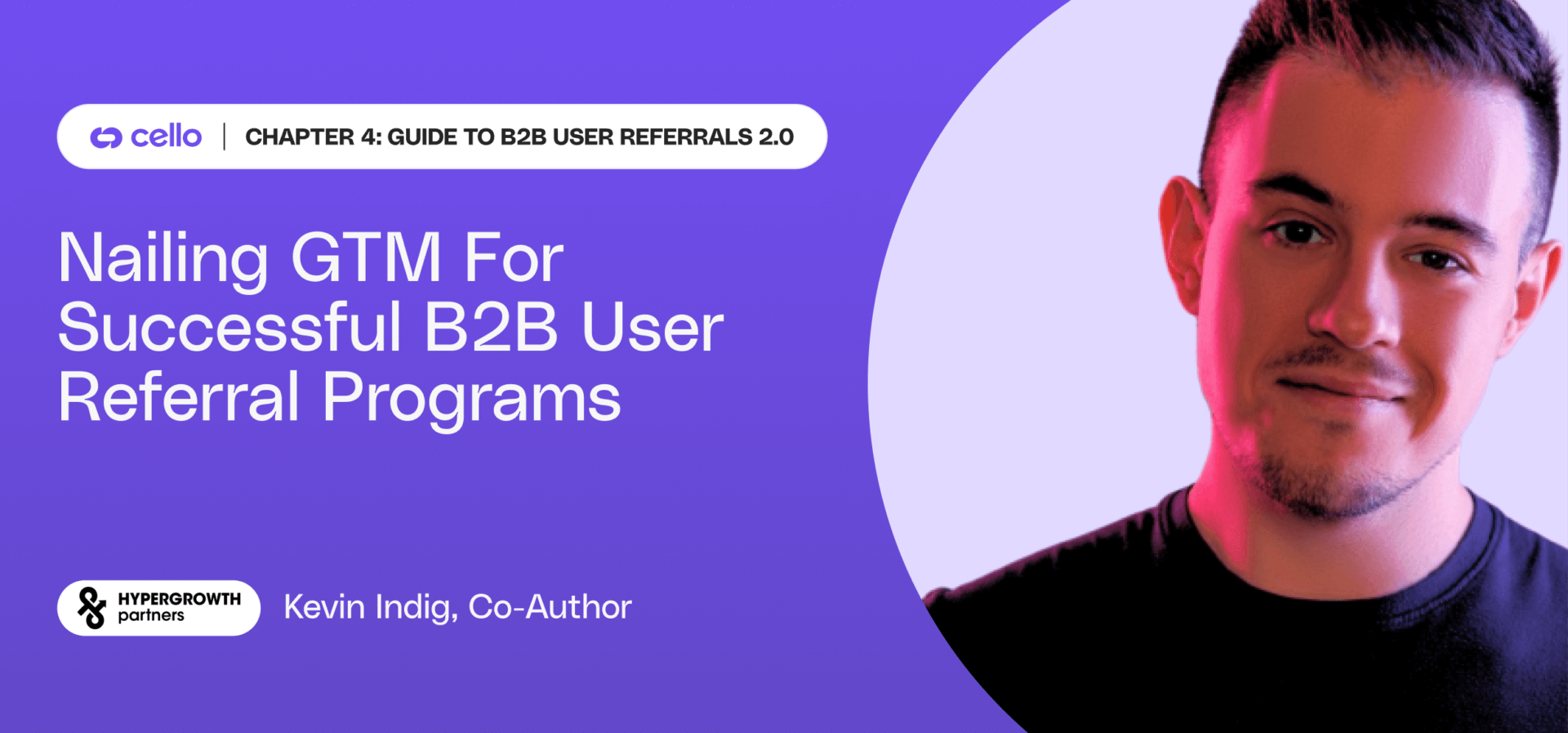🤝 In this chapter, we collaborate with Kevin Indig, a growth advisor with strong operator experience, to explore essential go-to-market (GTM) strategies for launching a successful B2B referral program. Kevin shares his experience with launching Shopify’s user referral loop in this article.
In previous chapters of the Guide to B2B User Referrals 2.0, we’ve learned that user-led growth promises to be a sustainable, high-growth channel (chapter 1). To make the user referral program spin, we’ve also learned how important in-product integration and UX are (chapter 2) and how pivotal the choice of the right incentive type (monetary private rewards, chapter 3) is.
The foundation has been laid out, now it’s time to launch your User Referral Program with a bang.
What will you learn in this chapter?
- What are the channels to successfully promote the launch of your user referral program?
- When and how do I launch my user referral program?
- What do I need to prepare pre and post launch?
- Why a multi-channel strategy?
- What does good look like?
Importance of the right GTM approach?
A well crafted go-to-market (GTM) strategy is essential for the success of a user referral program or any marketing campaign. Just to mention a few facts:
- Companies that prioritize strong GTM initatives are 13x more likely to see a positive ROI (HubSpot, 2020).
- Enhanced by solid GTM methods, referral programs achieve 4x higher conversion rates than traditional digital marketing (Reforge, 2021).
- Structured GTM planning makes firms 1.5x more likely to achieve above average growth (McKinsey & Company, 2022).
- 45% of product launches are delayed due to insufficient GTM planning (Gartner, 2020).
- Effective GTM strategy can improve retention rates by 5-10% and increase profits by up to 95% (Bain & Company, 2019).
The right GTM is crucial, so let’s recap general GTM strategies for B2B SaaS.
Together with Akash Bajwa, we elaborated on general GTM strategies for B2B SaaS.
- Product-Led Growth
- Sales-Led Growth
- Marketing-Led Growth
- User-Led Growth
To launch a referral program, a combination of the above strategies is needed. Preparation is the most important stage of the program's success. Let’s have a look at all of the pre-launch promotion steps.
Pre-Launch - preparation is everything
Plan the right channels and budget
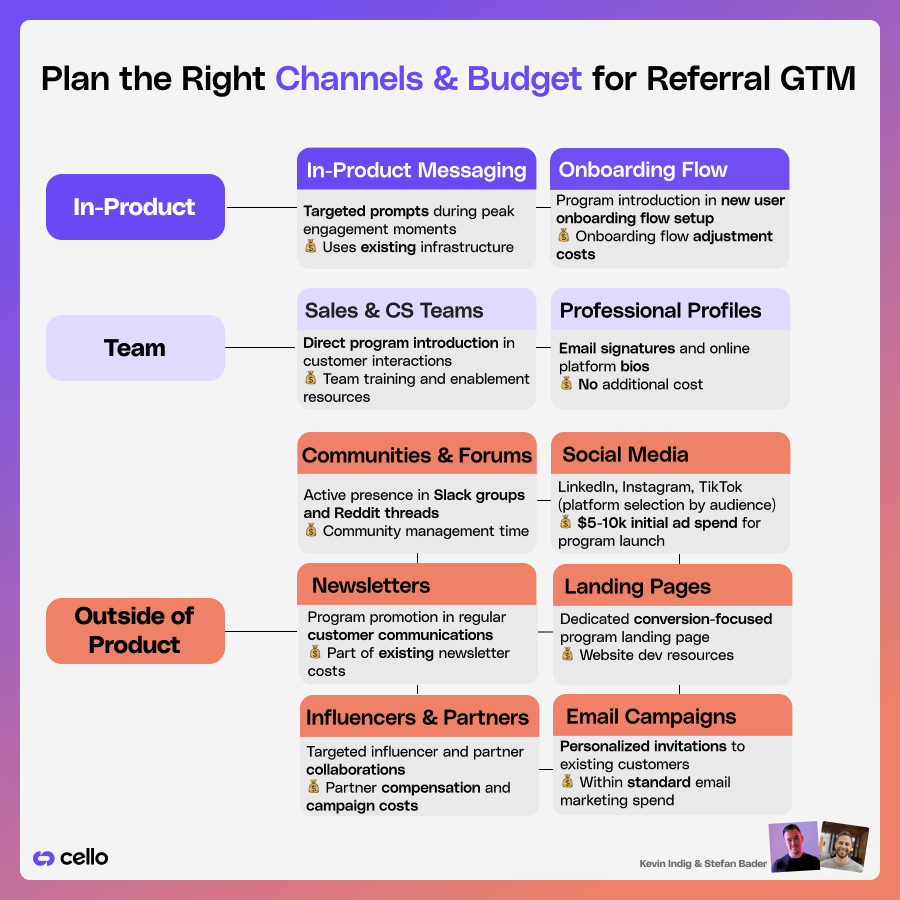
In-product messages
Utilize in-product messages and banners to seamlessly integrate the referral program into the user experience. Targeting users directly within your product can drive awareness and encourage participation at critical engagement points, such as after a successful transaction or achieving a milestone.
New users onboarding
Incorporate the referral program into your new user onboarding flow as a final step. This ensures every new user is aware of the opportunity to earn rewards. By introducing the program at the end of the onboarding process, you can seamlessly highlight its benefits and encourage immediate participation, setting users up for success from the start.
Incorporate your sales & customer success team
Empower your sales and customer success teams to introduce the referral program during client interactions, ensuring they are well-equipped with key messaging and incentives. This approach allows for personalized outreach, tapping into the team's relationships to boost program participation and build trust.
Updating profiles and signatures
Adding referral messages to bios and email signatures is an easy way to amplify visibility. It leverages existing channels like LinkedIn and email to passively promote the program, reaching professional networks with minimal effort.
Prepare email campaigns
Leverage email outreach to address existing users with personalized invitations to join the referral program. Highlight the benefits and rewards clearly while maintaining a sense of urgency to boost participation rates and keep the program top of mind.
Run newsletters
Incorporate the referral program launch into your newsletter strategy (for existing and potential new customers). You can even include it as a continuous call-to-action to inform users of the program's benefits. This keeps awareness high.
Prepare website landing page
Enhance visibility by creating a dedicated landing page for your referral program (see details below). This will not only attract attention from potential leads but could also appeal to affiliates and influencers, making it easier for them to engage with and promote your program.
Promote your program on Social Media (e.g. x/ LinkedIn)
Promote the referral program on social platforms like X, LinkedIn, Instagram, Facebook, TikTok or Snapchat. It really depends on where you can locate your target audience (e.g., vertical SaaS for hair dressers who would rather use Instagram or Tiktok) to reach the right audience and tap into your users' networks. Create compelling content that showcases success stories, user testimonials, and clear calls to action to amplify the program’s visibility and appeal.
💸 Depending on your company size and stage, $5-10k ad spend is reasonable to promote and kick-start the go-live of your referral program.
Communities and forums (Slack/ Reddit)
Engage with relevant communities and forums, such as Slack groups or Reddit threads, to foster organic conversations about the referral program. Encourage users to share their experiences and benefits, leveraging community trust to drive program credibility and adoption.
Influencers and partners
Partner with influencers and partners who resonate with your target audience to amplify the reach of your referral program. Leverage their credibility and established trust within their communities to create authentic content highlighting the benefits and rewards of participating in the program.
Plan and draft the right messages
Craft in-app notifications
In-app messages are used to build trust in the referral program, create fear of missing out and provide social proof.
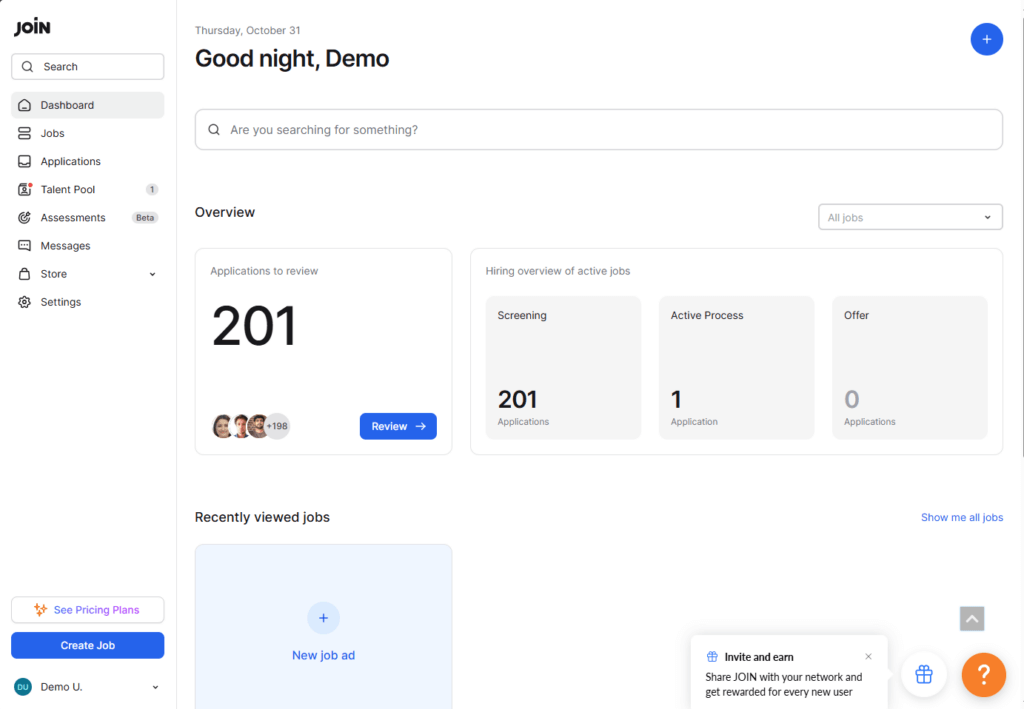
Make them short and crisp with a concise headline that clearly explains the reward to the referrer. Briefly describe the reward details in the smaller text. Make them appear when a new user logs-in or after crucial moments of delight (first transaction, upgraded to a higher paid plan, high NPS score).

Craft emails for user notifications
Add email notifications to nudge referrals and increase engagement outside your product. A well-written referral email should be clear, concise, and personalized. It should directly address the recipient and explain the benefits of the referral program. Include a strong call to action, a unique referral link, and visual elements to grab attention.
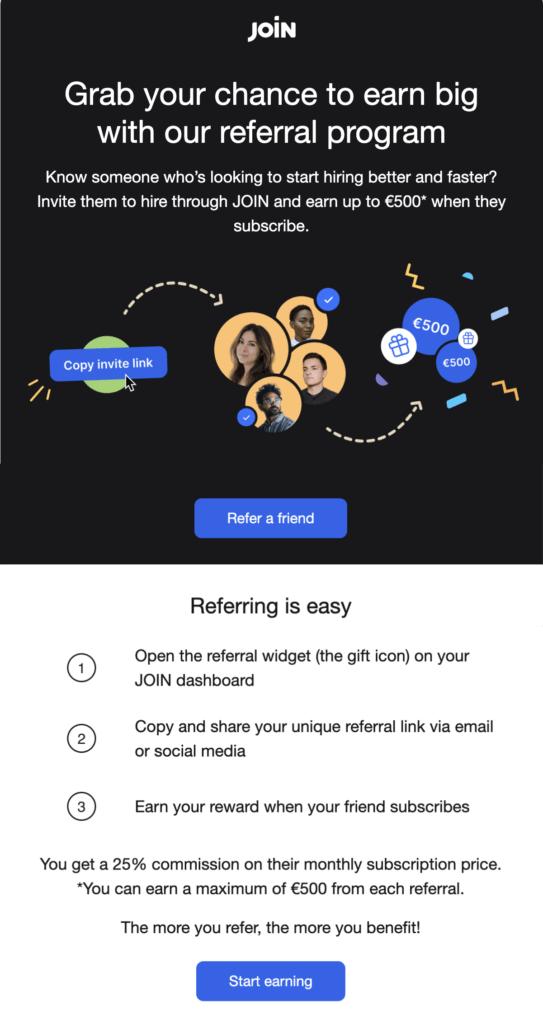
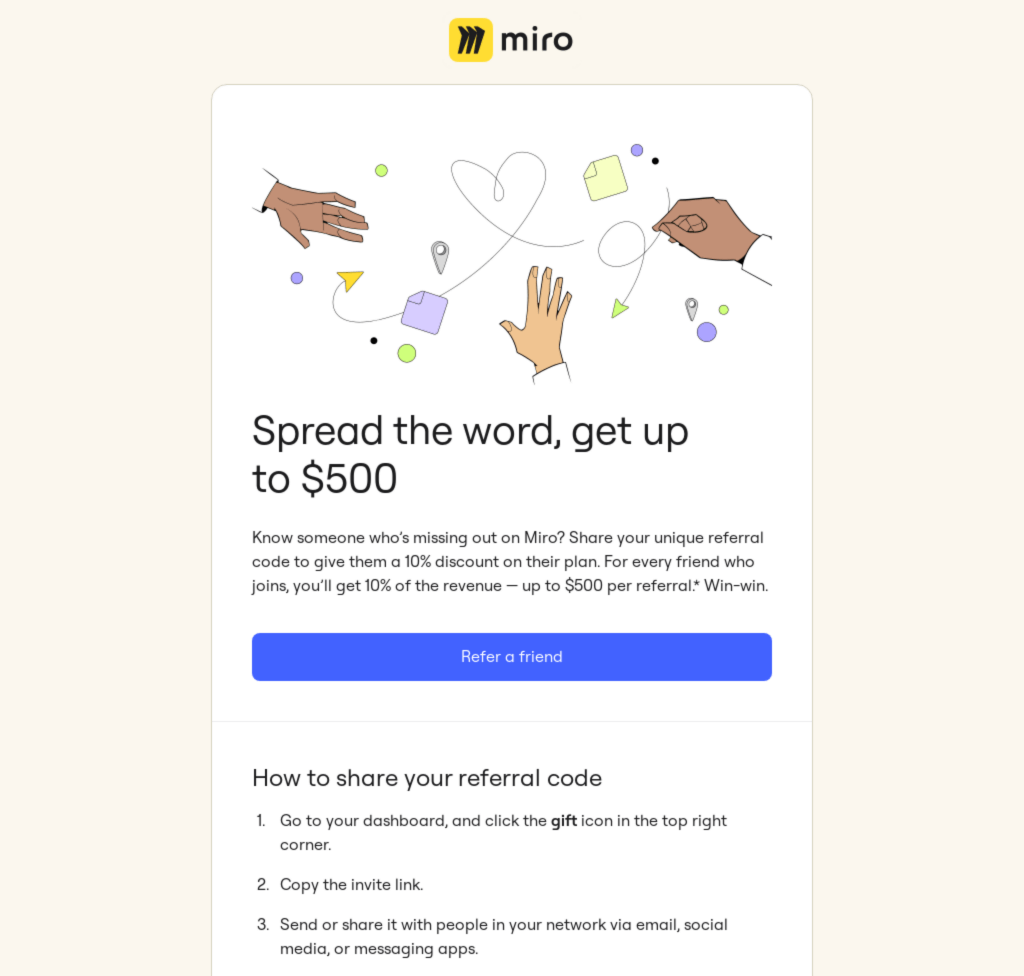
There are several types of referral email templates you could choose from:
- Invitation Emails: Introduce the referral program to customers and invite them to participate.
- Notification Emails: Inform customers when someone they referred has taken an action, such as signing up or making a purchase.
- Thank You/Re-engagement Emails: Show appreciation to customers for their referrals and encourage them to continue participating.
- Reminder Emails: Remind customers about the referral program and any pending rewards they can earn.
- Mass Emails: Reach a larger audience quickly, offering a compelling reason to join the referral program.
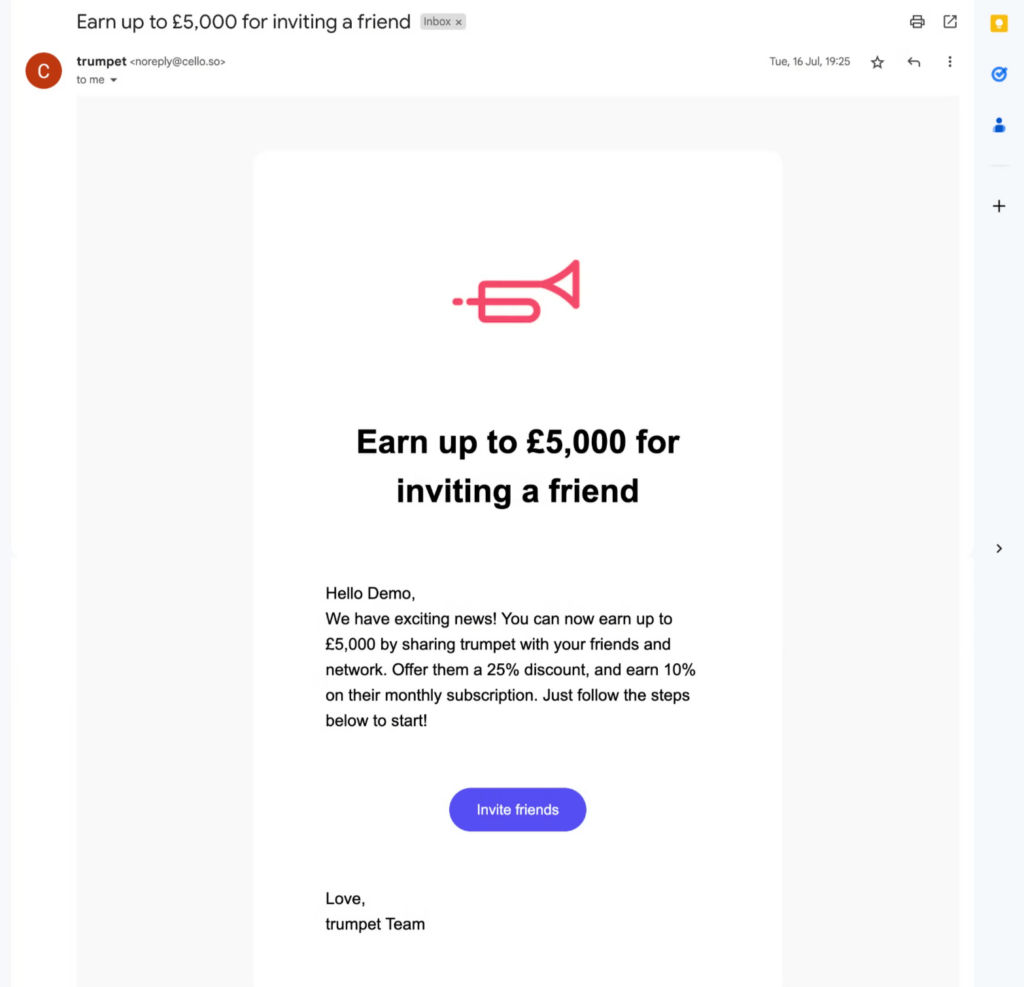
Craft go-live messages for social media
To create an engaging go-live post for X and LinkedIn announcing your user referral program, start with a compelling hook that grabs attention, such as "Exciting news! Our Referral Program is now LIVE!"
Clearly outline the steps for participating and highlight the reward, whether it's discounts, monetary payouts, or exclusive perks.
Use a carousel or a cheatsheet visual to detail each step and showcase the benefits. This makes it easy for users to understand how to join and what they can gain. Encourage followers to refer today and amplify your message with a strong call to action.
Don’t forget to make your employees spread the news as well.
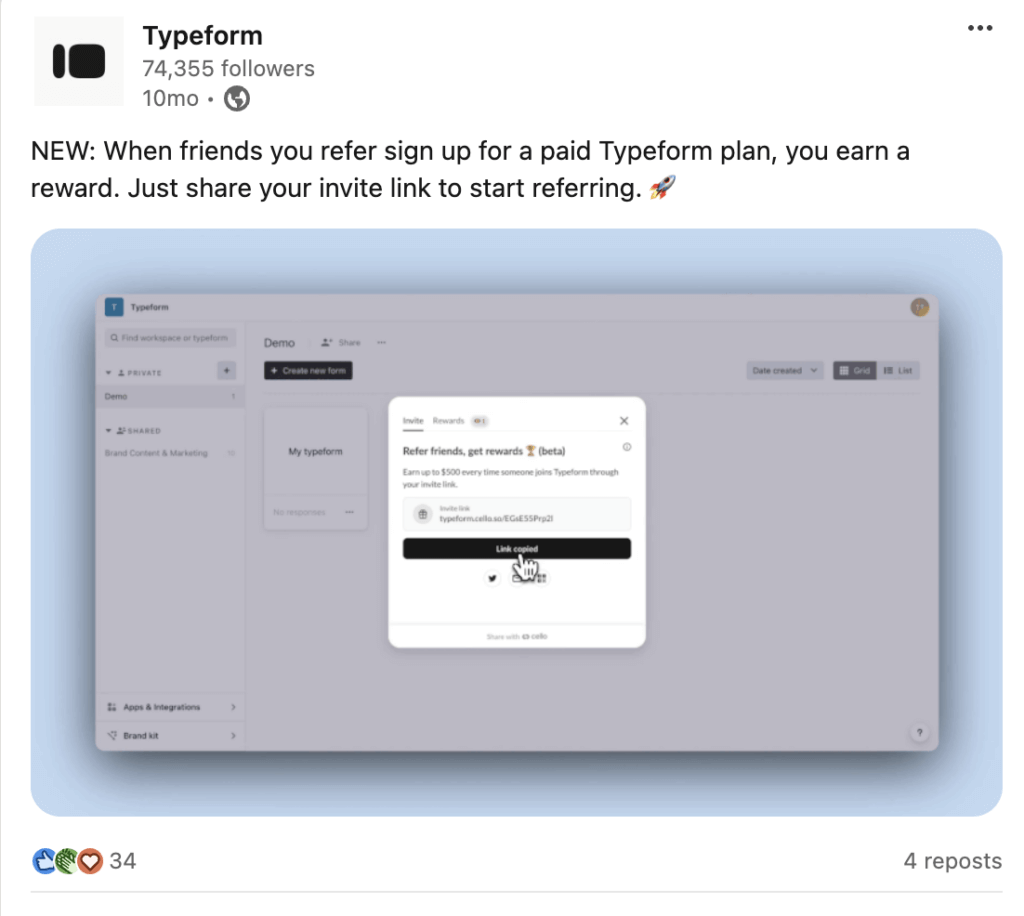

Prepare the landing page of your new program for ambassadors
A dedicated landing page on your website is crucial for any referral program. This page should clearly outline the program's benefits, structure, reward system, and payout terms (such as referral-based, one-time, or lifetime rewards). An excellent example of this is Fellow's ambassador program page. Make sure your landing page includes:
- An easy-to-understand value proposition.
- Visualize what’s in it for the referrer.
- Describe the referral process.
- Include a clear CTA to get started.
- Maintain a FAQ .
- Provide assets for sharing (message templates, media kit), e.g. s. further below.
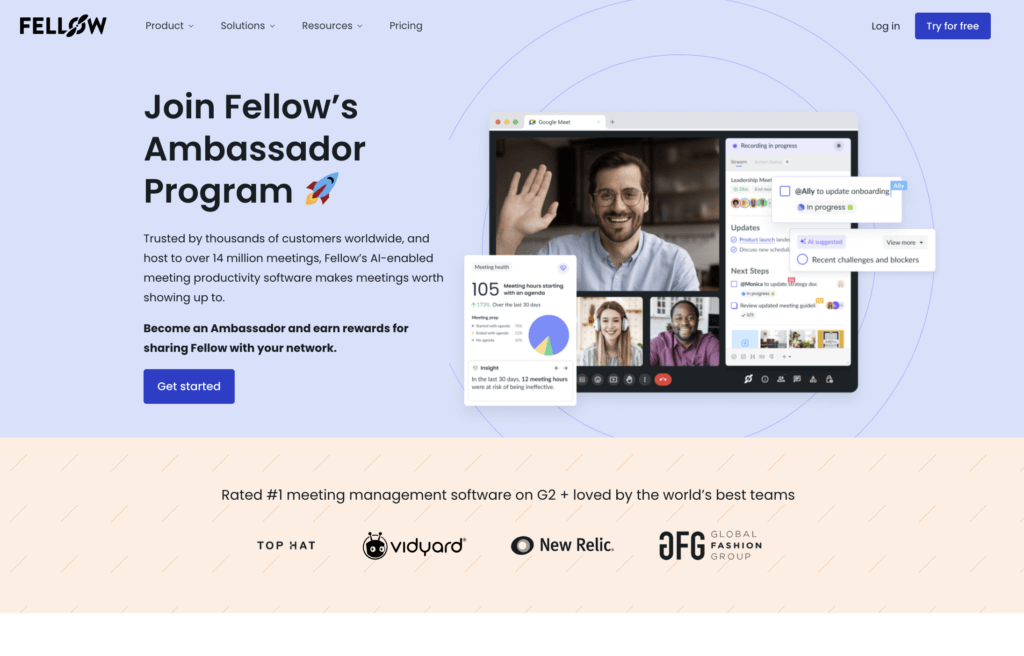
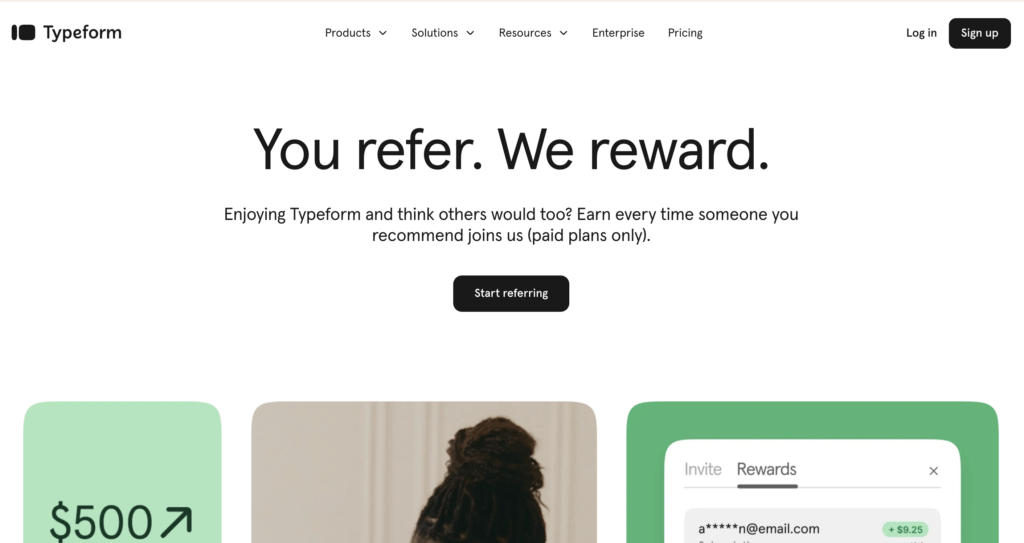
Prepare assets for referrers and influencers
Empower your referrers with user-friendly resources: Provide customizable templates that highlight your product's key benefits, focusing on how it solves specific problems. Incorporate compelling social proof, such as user testimonials or case studies, to showcase the real-world impact. Don't forget to include a strong, clear call to action to guide potential customers.
Referral resource example (inspired by tl;dv):
- Customizable email templates.
- Social media post suggestions.
- Shareable infographics showcasing product benefits.
- Short video tutorials for quick demonstrations.
- FAQ document addressing common prospect questions.

Equip your users with clear, concise messaging that effectively communicates your product's value proposition. Provide them with easy-to-use templates highlighting key benefits and unique selling points. For example, Butter offers a template for users to easily share the product's value.
Offer pre-written social media posts for effortless sharing. Here's an example from Gmelius:

To ensure you attract the right leads, provide clear guidelines on your ideal user profile. This helps potential referrers understand who would benefit most from your product. Some companies take this a step further by implementing smart referral systems. For example, certain platforms can analyze your contacts and suggest potential leads based on factors like email domains, ensuring a higher likelihood of finding well-matched customers.
Prepare the landing page for referees
The principles that apply to referrers also hold true for referees. Boost signup conversions by designing a personalized referral landing page that caters to the specific needs and expectations of new users, while leveraging social proof.
💡Cello’s proprietary data of 4M users could show that personalized sign-up referee pages lead to 214% signup rates!
Incorporate your sales & customer success team
Empower your sales and customer success teams to introduce the referral program during client interactions, ensuring they are well-equipped with key messaging and incentives. This approach allows for personalized outreach, tapping into the team’s relationships to boost program participation and build trust.
Let’s have a look at a few best practices:
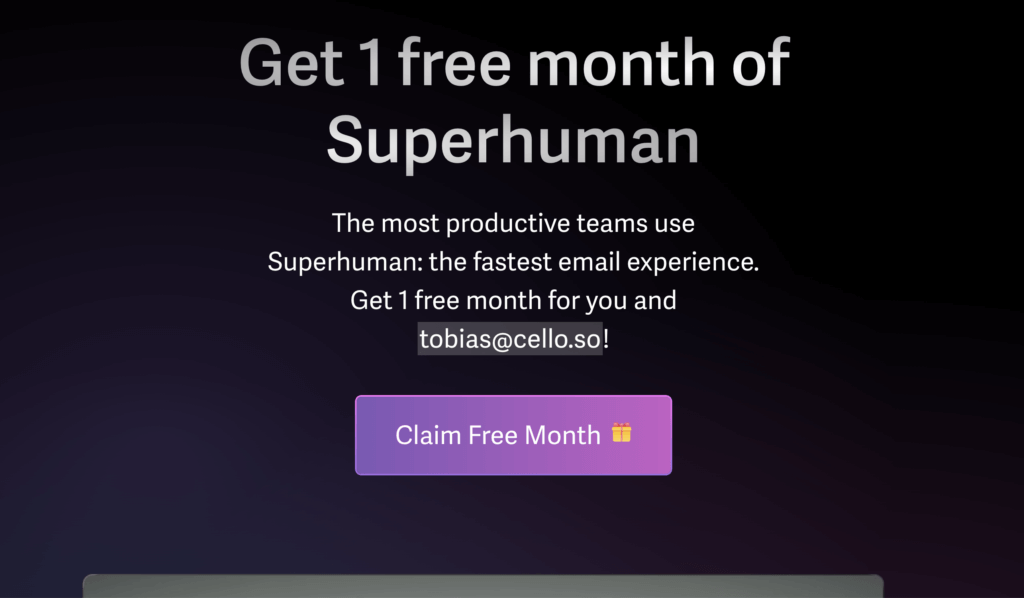
- Personalize the experience: Feature the referrer’s name on the landing page to build trust and foster a personal connection.
- Highlight new user discount: Make any special offers or discounts for new users highly visible to encourage faster signups.
- Compelling hero message: Showcase your main value proposition prominently to capture the attention of referred visitors.
- Engaging product visuals: Incorporate visuals that demonstrate your product’s key benefits, helping new users quickly grasp its value.
- Effective CTA: Ensure there is a clear, direct call-to-action for referred users to seamlessly start their onboarding process.
- Social proof elements: Enhance credibility with badges from platforms like G2, Capterra, and Trustpilot, along with customer logos and testimonials.
- Comprehensive FAQs: Address common queries new leads might have to alleviate concerns and reduce obstacles to signing up.
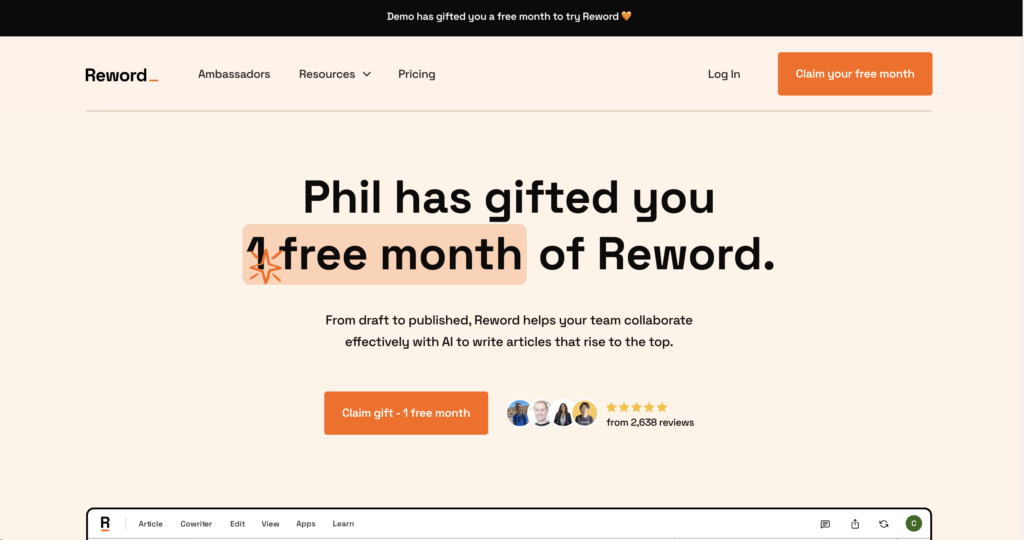
Plan a gradual roll-out
Consider an initial rollout with power users or influencers first. These users are often more forgiving and provide valuable feedback to help improve subsequent launches.
When implementing your referral program, consider a phased rollout approach. Start by identifying your target audience: this could be all users, a specific segment, or influential customers. A gradual launch strategy is often beneficial. Begin with your power users - they're typically more understanding and can provide invaluable insights to refine the program before a wider release. This approach allows you to gather feedback, make necessary adjustments, and ensure a smoother full-scale launch.
💡Power user targeting leads to higher activation of 16% per message, which allows to you to get valuable feedback on your program before rolling it out across your user base. You can simply target them with in-app messages.

Activate internal teams for success
To ensure the success of your referral program, activate internal teams by aligning with your sales and customer success teams. Provide them with key messaging, program details, and incentives to share with customers during their regular interactions. Empower these teams to become program advocates by equipping them with training and resources, like scripts and email templates, so they can confidently promote the referral program and encourage participation.
Ideally, you also set referral lead generation goals for the sales team, which they will be measured against. Incorporating these goals into their compensation plans is recommended.
Identify key metrics to track
Be prepared to track key performance indicators (KPIs) from the start to measure your program's impact and enable continuous improvement. Below is a table of relevant metrics.
There are various approaches to optimizing your referral program. While you can focus on increasing activation and sharing rates at the top of the funnel, we recommend starting with the bottom. Try to optimize conversion at the end of the funnel before pushing hard on activation. This strategy often yields better results.
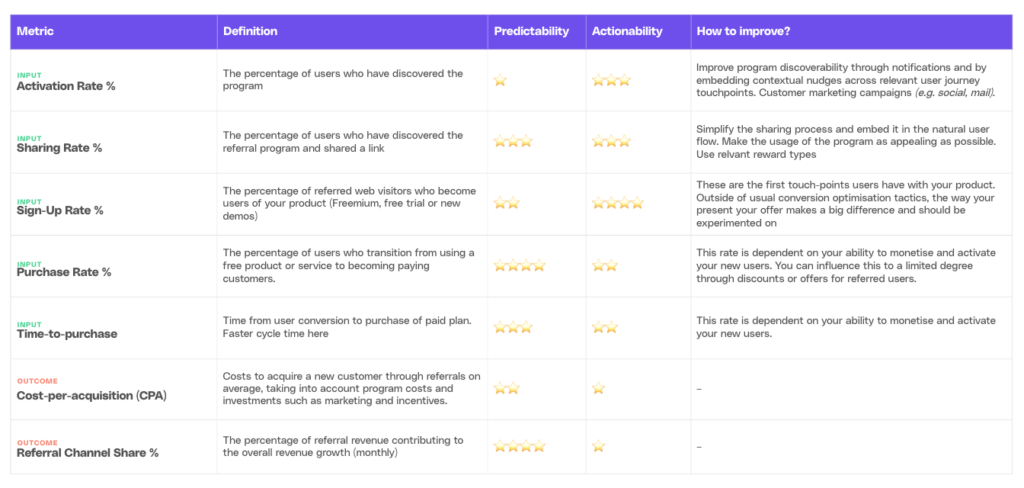
Launch day promotion - go live with a big bang
The day has come! Go live with a big bang and apply the above mentioned tactics.
Multi-channel promotion
Boost your referral program's visibility by promoting it across all key channels. Feature it prominently on your website's homepage and dedicated referral page.Include a compelling announcement in your newsletters to engage your existing customer base. Leverage social media platforms, and collaborate with influencers to reach new audiences. This multi-channel approach ensures maximum reach and drives user participation from various touchpoints.
Social postings
Create engaging social media content that highlights the benefits of your referral program. Use a mix of static images, videos, and carousel posts to explain the steps involved and showcase rewards. Encourage followers to share their experiences and tag friends, boosting organic reach and engagement. Regularly update with fresh content, success stories, and user testimonials to keep the momentum going.
Word by the CEO
Add a personal touch with a CEO message or video, similar to Plancraft's example. The CEO can share why this referral program is an exciting opportunity for the community, express gratitude to existing customers, and outline the program's benefits and simple steps to get started. A direct, heartfelt message can build trust, encourage participation, and create a shared purpose among customers.
Post-launch day - keep engagement high
Implement continuous nudges to keep your user base engaged and maintain high activation and sharing rates. As discussed in Chapter 2 of this ultimate guide to B2B user referrals, where we explored UX and in-product integration with Aakash Gupta, it's crucial to embed these nudges natively throughout the user journey.
In-product
Notifications
To keep users engaged and informed throughout the referral funnel lifecycle, enable essential notifications at key stages. Share referral links via email, making it easy for users to forward them to their network and simplify the sharing process. Regularly update referrers on the performance of their referral links, even outside the product, to maintain their engagement and motivation. Celebrate successful referrals to recognize the referrers' efforts and encourage them to continue sharing.
💡 These tactics can lead to up to a 227% higher activation rate, maximizing the impact of your referral program. (Cello proprietary data)
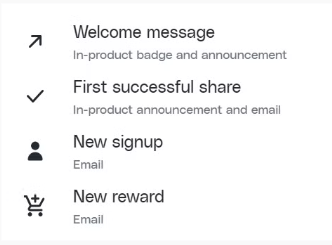

Activation Campaign
Implement activation campaigns that utilize pop-up notifications at strategic intervals—such as 7, 14, and 21 days—to remind users about the referral program. These notifications should be integrated thoughtfully throughout the user journey to keep the program visible and top of mind without disrupting the overall experience.
💡 This approach can significantly boost engagement, leading to a potential 164% higher activation rate and enhancing the program’s overall effectiveness. (Cello proprietary data)
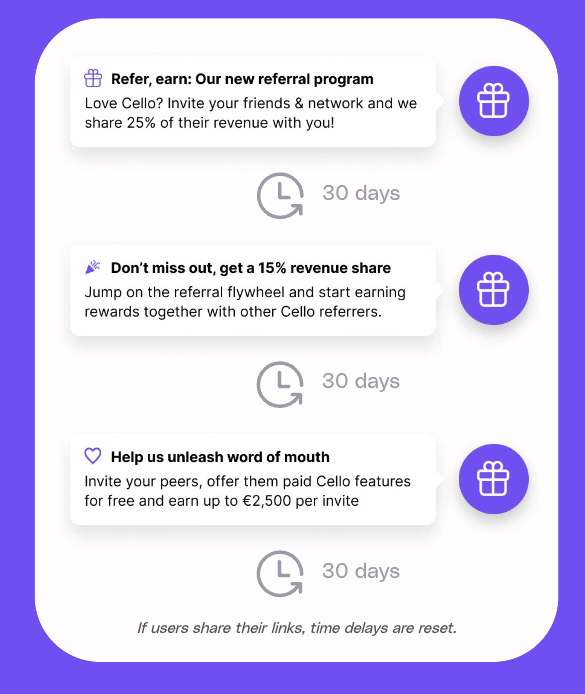
A/B test
Growth is about experimenting, so are referral growth loops. Be it the widget copy, email copy and above all the reward structure. Try to A/B test as much as possible to find the ideal setup.
Outside app promotion
Welcome email
Incorporate a welcome email into your user onboarding process to boost engagement and activation. Send this email to new users 7 days after their first login, reinforcing their decision to use your tool and introducing them to the referral program.
💡 This timely communication can enhance user experience and lead to a potential 141% higher activation rate, setting the stage for long-term success with your product
Highlight top ambassadors
You likely have a group of power users who are also your most successful referrers. Celebrate these top ambassadors by creating short success stories that showcase their achievements. Encourage them to share their experiences on social media, recognizing them as top ambassadors. Their stories not only spread the word but also inspire others to engage with your referral program.
Conclusion
Launching and sustaining a successful B2B referral program requires a strategic, well-executed go-to-market (GTM) plan that harnesses the power of multi-channel promotion, personalized user experiences, and continuous engagement.
By preparing thorough pre-launch assets, incorporating in-product and email notifications, and leveraging social proof and influencer partnerships, companies can amplify their reach and maintain high participation rates.
The integration of thoughtful follow-ups and engagement campaigns post-launch will ensure the program stays top of mind and achieves sustained growth. Remember, the foundation of a strong referral program is not just in the initial launch but in the ongoing effort to optimize, engage, and refine your strategy for long-term success.
Resources
Related Articles
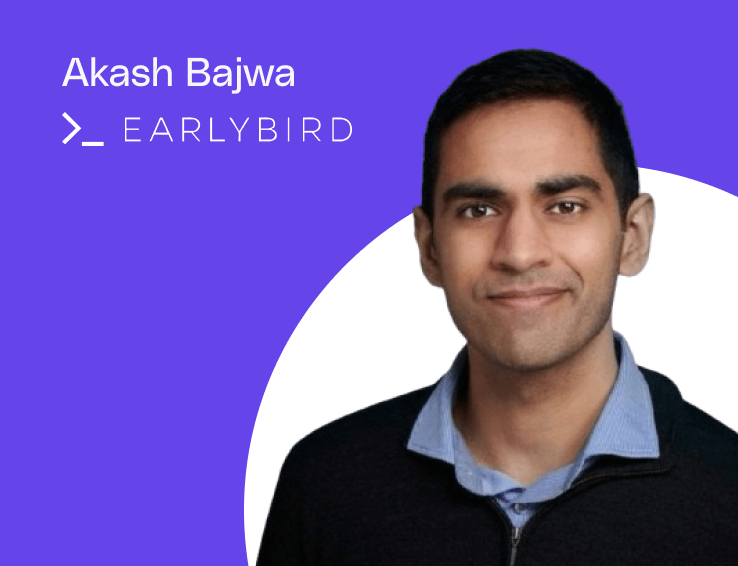
The untapped channel across GTM strategies for B2B SaaS: User Referrals
Discover actionable tips & the complete process to launch your own influencer referral program

Building a habit – Interplay between product & UX for successful B2B user referral program adoption
Discover actionable tips & the complete process to launch your own influencer referral program

The Ultimate Guide to B2B Influencer Referral Programs
Discover actionable tips & the complete process to launch your own influencer referral program
